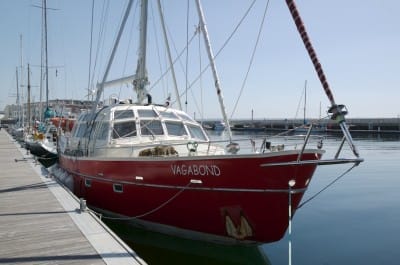
There’s no mistaking the profile of certain boats, so it was easy for us to recognise the red yacht transiting the Caledonian Canal one day in early April, despite the near blizzard conditions at the time. Vagabond is a well-known yacht in polar circles, and there is really nothing quite like her visually.
Built in 1979 in France originally as ketch, she is now cutter rigged and has had a deckhouse added to the original design. Since 1999 she has been owned by Eric Brossier, who, with his partner France Pinczon du Sel and (more recently) their two daughters have notched up an impressive record of polar firsts with her.
First North Pole Circumnavigation
Between 2002-3 for example, they completed the first polar circumnavigation via both the North East and North west passages. The North East passage was particularly impressive, being the first yacht to make the passage without wintering or the assistance of an ice-breaker.
Between October 2004 and July 2009 she was engaged in a European Union funded climate change research project called Damocles, spending five winters ice bound in East Spitsbergen. With her crew actively engaged in the research, as well as communications and film work, she also acted as a base camp for other scientists involved in the project, a role she has been specially modified to carry out, whatever the conditions.
We saw her again in the marina in Brest early this summer, where she looked like a tank parked amidst a fleet of fairground dodgem cars. Although not a huge boat at around 47ft, her looks are dominated by the huge aluminium deckhouse, which makes her seem far bigger. She has relatively shoal draft of around 4ft., and with her twin engines with their protected props, seems more of a motor sailor than a pure sailing yacht, which, given her unique role, probably makes more sense. Designed (like other polar yachts such as Northabout) by Gilbert Caroff, she has many of his trademark features such as the ice-breaker bow. Everything aboard seemed functional and massively strong, as no doubt it needs to be.
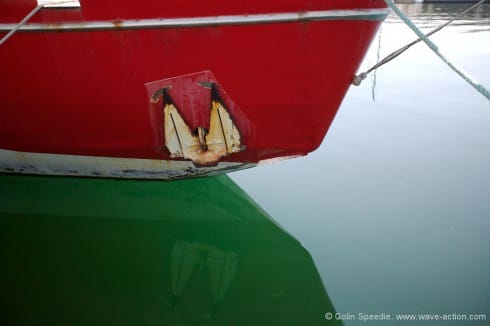
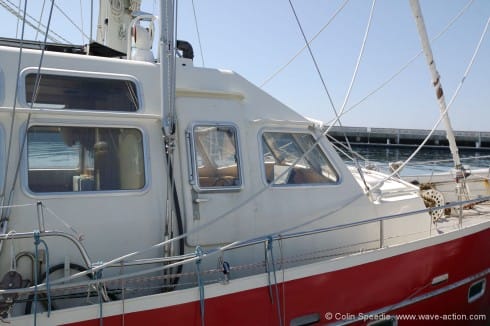

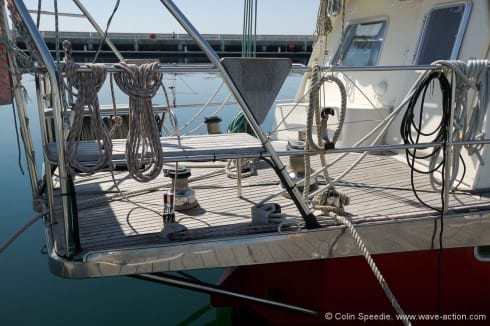
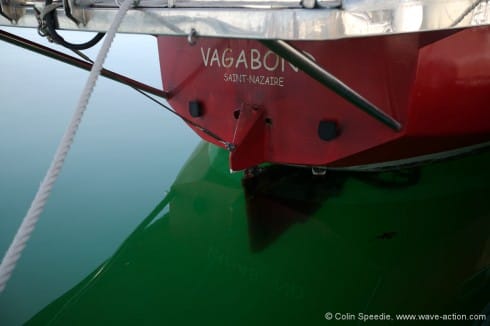
Future Plans
Vagabond has recently been declared a Heritage Interest Ship in France, where she is currently undergoing a major refit. She is due to depart at the beginning of May 2011 for North-west Greenland and Ellesmere Island to take part in a research project on walruses. Meanwhile her intrepid family crew are currently in East Greenland aboard a kite-assisted aluminum motor yacht called Ecotroll, exploring new ways of making such voyages, and evaluating ways of reducing the environmental cost of power driven craft. You have to admire the courage and dedication of such people, and their commitment to the polar environment, and I for one will be watching their progress as Vagabond heads out once more next year.

Colin: I may have missed it. Is this boat steel or alloy? I would imagine steel to have enough ballast to counteract that heavy, but no doubt warm, pilothouse.
Have you thought how you might have a pilot or dog house welded up for your Ovni? Maybe I am a wimp but I hate being cold. In the Pacific Northwest a 60 F day is considered warm but not by me.
Cheers
Victor
Apparently she is constructed from a high resilience steel, whilst the deck house is in aluminium, presumably to keep weight down above deck level.
When we had our boat built we specified what was called a ‘wave breaker’, which is welded to the coachroof and houses our instruments – wind etc. The sprayhood (dodger) attaches to this, and we specified it so that it would be easier to weld a fabricated dog house to the boat at some time in the future. We’ll probably go for a structure in aluminium as it will be easier, but equally we’re open to the idea of fabricating it in modern composites, but that would entail bonding and bolting to the wave breaker. Our main aim will be to construct a light, strong structure that can protect the hatchway, mount grab rails and solar panels. We’ve plenty of time to work the idea up, as the existing structure is still in good condition, and we’ll watch technical developments in the meantime, do our homework and (hopefully) select the best way to go. Any comments would be gratefully accepted!
Best wishes
Colin
Colin,
Without pictures, I am assuming what you have is basically a windshield welded to your coach roof and your fabric dodger is attached to that. I have seen similar arrangements before. Adding a “roof” to that for solar panels, grab rails etc. won’t be rocket science but will require homework and compromises. One compromise is whether to allow standup or sit down headroom or something in between. The next consideration will be to make it watertight (complicated) or just wind and water resistant. In case of a rollover it certainly would be helpful to have an airtight bubble on top to encourage the boat to snap back quickly to upright. It might even help rolling totally inverted since it is buoyant. If you go this route then you will have to reroute all your lines that are routed to the coach roof. Boreal has solved this problem pretty well but it will be a big project for you considering what you have already.
I have solutions without being totally watertight that looked pretty bombproof. Some are equipped with a heavy canvas back wall and access door and others have installed a solid wall with a fairly substantial watertight door.
Garcia supplies a substantial arch just aft of the companionway hatch which provides a good starting point for further protection depending on your needs and wants.
Good luck and I look forward to following your decision making.
Cheers
Victor
Hey Colin,
I have a friend – Nicole van de Kerchove – who spent several months alone (with some dogs), in the winter, in the ice of Spitsbergen on board of Vagabond… She loved it and felt Vagabond was very very comfortable to live on. If you want to, I have some amazing pictures to share…
Best regards,
Jean-François
Hi Jean-François,
We would love to publish such photographs here at AAC if it is OK with the photographer. Just send them attached to an email and we can take it from there.
Hi Everyone,
It’s a shame that first years of Vagabond and its arctic cruises are not widely known.
So, a short story. Vagabond (first name Vagabond II or Vagabond’eux) was built by G.Caroff for Polish sailor and scientist Janusz Kurbiel. Vagabond I (Chatam) was Kurbiel’s first yacht which also sailed high latitudes. Vagabond II was “by design” made for long arctic cruises. At first it was a ketch than redesigned as a sloop. It has a much smaller deckhouse too.
She sailed a scientific expedition to Magnetic North Pole, and made a few other arctic cruises before sailing North West Passage (as a first yacht from West to East).
This cruise (Le Havre-Panama-Vancouver-Tuktoyaktuk-Gjoa Haven-Brest) took place in 1984-1988 with wintering in Tuktoyaktuk and Gjoa Haven (twice). It was 38th passage since Amundsen’s successful attempt in 1906.
The passage was done by Wojciech Jacobson and Ludomir Maczka with Janusz and Joelle Kurbiels assistance in some stages.
Vagabond II was sold to Eric Brossier in 1999. Janusz Kurbiel than owned Vagabond III and now is sailing onboard Vagabond’elle, a wooden yacht made also for high latitudes.
Regards
Peter
Hi Piotr,
Thanks very much for the update on Vagabond`s fascinating history.
One thing: I think maybe John Bockstoce’s motor sailor Belvedere may have been the first yacht through the NW Passage west to east, although I’m not certain of that. Anyone know for sure?
Hi John,
I don’t know exact dates and places but Vagabond left Greenland to Europe mid September 1988. According to Wojciech Jacobson it was Canadian Coast Guard who called them “first yacht”. Maybe it was first sailing yacht?
Another rather unknown fact about NW Passage is that first real attempt to cross it by yacht was in 1975 by Polish sailors on 20m schooner named Gedania (also design for high lattitudes). They sailed up to Resolute Bay but Canadians refused them to sail further, so expedition headed south around Horn.
Best regards,
Peter
Hi Peter,
There seems to be some confusion about the first through issue, so I’m not sure either. But no matter, it’s a great achievement, first or not. Particularly in the 80s when the ice conditions were very challenging and a forced over-winter was almost guaranteed.
Great link, thanks. I had no idea about that expedition.
Over the years, we have met a much larger proportion of Polish boats in the Arctic than the size of your country would lead one to expect.
If I am not mistaken she was in Vancouver at Granville Island today.
Is that possible – if not, the vessel there had just arrived via the NW Passage